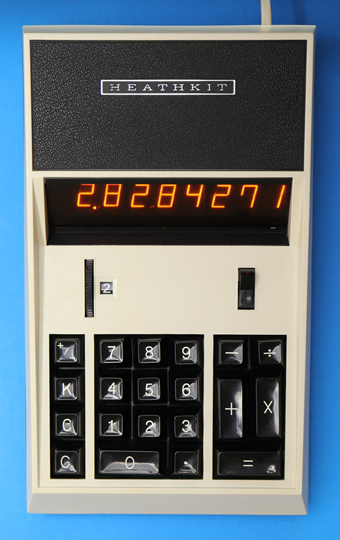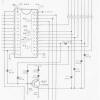
DATAMATH CALCULATOR MUSEUM
 |
DATAMATH CALCULATOR MUSEUM |
Heathkit IC-2008A
| Date of introduction: | April 1972 | Display technology: | Panaplex II |
| New price: | $139.95 | Display size: | 8 |
| Size: | 10.2" x 6.0" x 3.4" 260 x 153 x 88 mm3 |
||
| Weight: | 46.5 ounces, 1,320 grams | Serial No: | Production batch 00217 |
| Batteries: | Date of manufacture: | mth 05 year 1972 | |
| AC-Adapter: | 120 V or 240 V | Origin of manufacture: | USA |
| Precision: | 8 | Integrated circuits: | TMS0101 |
| Memories: | Displays: | 3*Sperry SP-753 | |
| Program steps: | Courtesy of: | Joerg Woerner |

![]()
 "Houston, we have a problem" might have been for Heath Company in Spring 1972 a
"Dallas, we have a problem". Shortly after the introduction of the Heathkit
IC-2008 Desktop calculator, Texas Instruments decided to discontinue the
TMS1875 single-chip calculator circuit to focus on the more lucrative TMS0100 Product Family. And the IC-2008 was selling like hotcake, probably around
1,000 units per months at a typical price of $139.95 (around $1,000 in 2023 money) per unit. Heath needed a solution, and they needed the solution quick. Enter IC-2008A.
"Houston, we have a problem" might have been for Heath Company in Spring 1972 a
"Dallas, we have a problem". Shortly after the introduction of the Heathkit
IC-2008 Desktop calculator, Texas Instruments decided to discontinue the
TMS1875 single-chip calculator circuit to focus on the more lucrative TMS0100 Product Family. And the IC-2008 was selling like hotcake, probably around
1,000 units per months at a typical price of $139.95 (around $1,000 in 2023 money) per unit. Heath needed a solution, and they needed the solution quick. Enter IC-2008A.
 At first glance you won’t notice any differences between the IC-2008A and its short-lived predecessor IC-2008, it still takes up to one minute before the display is fully functional and the operated is greeted with a glowing, neon-orange 'ooooooo0.' display. Looking closely at the display you may notice that the font of the numeral '7' is different, the IC-2008A uses 4 bars of the 7-Segment planar neon gas discharge display while the IC-2008 uses one bar less. Even more confusing is the IC-2008 advertisement in Heath’ August 1972 retail store catalog, it clearly shows the IC-2008, prices the IC-2008 but adds a photograph of a
TMS0101 single-chip calculator circuit with the caption “Reliable Texas Instruments LSI logic chip is the brain of the IC-2008.
At first glance you won’t notice any differences between the IC-2008A and its short-lived predecessor IC-2008, it still takes up to one minute before the display is fully functional and the operated is greeted with a glowing, neon-orange 'ooooooo0.' display. Looking closely at the display you may notice that the font of the numeral '7' is different, the IC-2008A uses 4 bars of the 7-Segment planar neon gas discharge display while the IC-2008 uses one bar less. Even more confusing is the IC-2008 advertisement in Heath’ August 1972 retail store catalog, it clearly shows the IC-2008, prices the IC-2008 but adds a photograph of a
TMS0101 single-chip calculator circuit with the caption “Reliable Texas Instruments LSI logic chip is the brain of the IC-2008.
![]() We know the TMS0101 chip very well from the Canon LE-80 calculator and out of curiosity put one into the socket of a fully functional IC-2008 calculator
(not recommended). No surprises here, the resulting Franken-Calculator showed as expected the numeral '7' with 4 bars and was missing the
"half-zeros".
We know the TMS0101 chip very well from the Canon LE-80 calculator and out of curiosity put one into the socket of a fully functional IC-2008 calculator
(not recommended). No surprises here, the resulting Franken-Calculator showed as expected the numeral '7' with 4 bars and was missing the
"half-zeros".

 Dismantling the featured Heathkit IC-2008A calculator sold in
May 1972 to an American hobbyist and assembled in picture-perfect quality, reveals indeed a design centered around a TMS0101 chip and
someone needs to dig deep into the used components to spot any differences to the original IC-2008 device. Unquestionably there must be a difference, a native TMS0101 chip doesn’t output
"half-zeros" on its three 3-digit Sperry
SP-753 planar neon gas discharge "Panaplex
II" display modules, it always supports leading-zero suppression.
Dismantling the featured Heathkit IC-2008A calculator sold in
May 1972 to an American hobbyist and assembled in picture-perfect quality, reveals indeed a design centered around a TMS0101 chip and
someone needs to dig deep into the used components to spot any differences to the original IC-2008 device. Unquestionably there must be a difference, a native TMS0101 chip doesn’t output
"half-zeros" on its three 3-digit Sperry
SP-753 planar neon gas discharge "Panaplex
II" display modules, it always supports leading-zero suppression.

![]() Understanding the modifications of one
Product Term in the 7-Segment Decoder of the
TMS1875 chip and studying the schematics of the IC-2008A calculators gives a simple explanation: Heath actually modified the Segment Decoder of the TMS0101 with external logic to
"overwrite" its blanking logic with a simple workaround:
Understanding the modifications of one
Product Term in the 7-Segment Decoder of the
TMS1875 chip and studying the schematics of the IC-2008A calculators gives a simple explanation: Heath actually modified the Segment Decoder of the TMS0101 with external logic to
"overwrite" its blanking logic with a simple workaround:
| • If the TMS0101 is outputting a blank 7-Segment pattern on
Digit Positions D1 (right most digit) to D8 (second digit from the left), modify the output pattern to a "half-zero". |
The actual implementation is very simple:
| • One transistor (Q27) detects if the TMS0101 is not scanning
Digit Position D11, meaning it is scanning any other Digit Position between D1 and D10 • Two diodes (D10, D11) detect if neither Segment B nor Segment C is activated, meaning a blank 7-Segment pattern is output • If both conditions are true, are four diodes (D14-D17) pulling the segment outputs C, D, E, and G high to output a "half-zero" • With two diodes (D9, D14) a logical OR for the Segment C to protect the output driver of the TMS0101 |
![]() The seven additional components are easily recognized on the layout of the IC-2008A printed circuit board (PCB) and component placements demonstrate that these changes were a last-minute afterthought to keep production of the calculator running.
The seven additional components are easily recognized on the layout of the IC-2008A printed circuit board (PCB) and component placements demonstrate that these changes were a last-minute afterthought to keep production of the calculator running.
 Here at the Datamath Calculator Museum we have a full stack of measuring devices available to dig deeper into the innards of electronic calculators including but not limited to voltmeters, frequency counters, analog and digital oscilloscopes and even logic analyzers. But these measurements are usually performed within the circuitry of a specific calculator and in many cases are not all features of a calculator chip used in the design. Consequently are we using our
DCM-50A Platform for the
Characterization of Single-Chip Calculator Circuits, an environment to access all features of
TMS0100 Product Family members and later developments like the
TMS0600, TMS0800, and
TMS1000 devices.
Here at the Datamath Calculator Museum we have a full stack of measuring devices available to dig deeper into the innards of electronic calculators including but not limited to voltmeters, frequency counters, analog and digital oscilloscopes and even logic analyzers. But these measurements are usually performed within the circuitry of a specific calculator and in many cases are not all features of a calculator chip used in the design. Consequently are we using our
DCM-50A Platform for the
Characterization of Single-Chip Calculator Circuits, an environment to access all features of
TMS0100 Product Family members and later developments like the
TMS0600, TMS0800, and
TMS1000 devices.
Comparing both the TMS1875 from the original Heathkit IC-2008 calculator and the TMS0101 from the featured IC-2008A calculator shows only three minor differences:
| • Different fonts for the numeral '7' • Leading-zero suppression modified to output "half-zeros" for the TMS1875 • Segment H output driver always activated for the TMS1875 |
All other features like registering of decimal point entry, rounding/truncation of calculating results, operations with a constant, and others are 100% identical and we assume that both chips are using identical software in their respective program memories.
The life cycle of the Heathkit IC-2008A was much longer than the short-lived IC-2008, it was replaced in December 1973 with the IC-2108, featuring again a Sperry (actually Beckman after their acquisition of Sperry Rand Corporation’s Sperry Information Displays Division in 1973) planar neon gas discharge display and a Texas Instruments calculator brain. And yes, meanwhile Texas Instruments entered the market of Electronic Desktop calculators, too. Don't miss the Deskmath LP3000 and its more common successor, the TI-3000.
If you have additions to the above article please email: joerg@datamath.org.
© Joerg Woerner, December 5, 2001. No reprints without written permission.